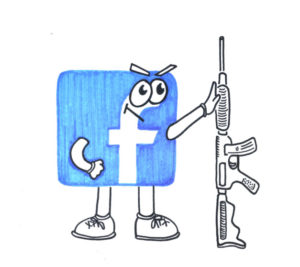The staff editorial is the majority opinion of The Murray State News Editorial Board

For many, Easter Sunday was a peaceful celebration with family, complete with egg hunts, elaborate meals and spring decorating – a time to turn away from the negativity and crime broadcast on the news.
For one family, however, April 16 was a day of loss and pain, and millions of people were witnesses.
On Sunday, a man named Steve Stephens murdered 74-year-old Robert Goodwin and livestreamed the heinous crime on Facebook for the world to see in detail. Since then, it has been reported that Stephens shot himself.
Aside from the sheer terror of the homicide, the event is stirring up a debate about Facebook and its responsibility.
It took almost two hours for the video of the murder to be removed from Facebook, according to a story in The New York Times. During that time, the video was watched, shared and circulated on other platforms by people outraged by what happened, but ultimately, the majority of those viewers didn’t intervene. They simply engaged in the killing spectacle behind the safety of their smartphones or laptops while a family faced the death of a loved one.
How can Facebook do a better job of preventing these kinds of violent videos from being live-streamed without inhibiting personal privacy? Shouldn’t there be some kind of gatekeeping system in place?
While heavily censoring video before its release – or getting rid of the live video function altogether – might seem like an extreme idea, Facebook and similar platforms could turn into a cesspool of dark content if no one makes drastic changes.
Apart from inappropriate photos and videos that already circulate on social media, there have already been other attacks and crimes broadcast using Facebook Live since its inception. As long as ill-minded people have access to such technology, they will use it to draw attention to their crimes if there is not serious preventative action.
What’s most frightening is the fact that, as viewers, we’ve already become desensitized to these kinds of posts. Because we are so used to seeing and hearing about detestable crimes via television, radio and other outlets, seeing a murder on Facebook is unfortunately not as shocking as it should be.
As a modern society, we look back at ancient killing spectacles – public hangings, beheadings and fights to the death – as barbaric and unimaginable.
But how different is it, really? Our coliseums and guillotines might be pixelated on a computer screen, but the dynamic is the same: we’re consuming acts of violence in the same space we consume entertainment. Why hasn’t Facebook done something drastic, like disabled the live video function?
Platforms like Facebook, Twitter and Instagram are supposed to be places for family and friends to share memories and engage in entertainment in order to bring each other joy and creatively express themselves. Social media is an escape – but when violence, murder and mayhem begin to infest those spaces, we could spiraling into a dangerous state as a society.
Either our platforms become more inundated with negative news, or they become extremely censored via artificial intelligence and human content monitors. As long as human beings still commit horrible crimes, there will be no middle ground for media.
Facebook’s administrators must make a tough decision – will they continue to give users as much freedom as possible and subject them to the sickening content that seeps through, or will they enforce more strict censorship policies in order to protect their users?
At the end of the day, responsibility lies with users, too. If you witness a troubling post, do not be a bystander. Act as you would if witnessing it in person: do something. Stand up for what’s right, and don’t share violence for the sake of sensational entertainment.